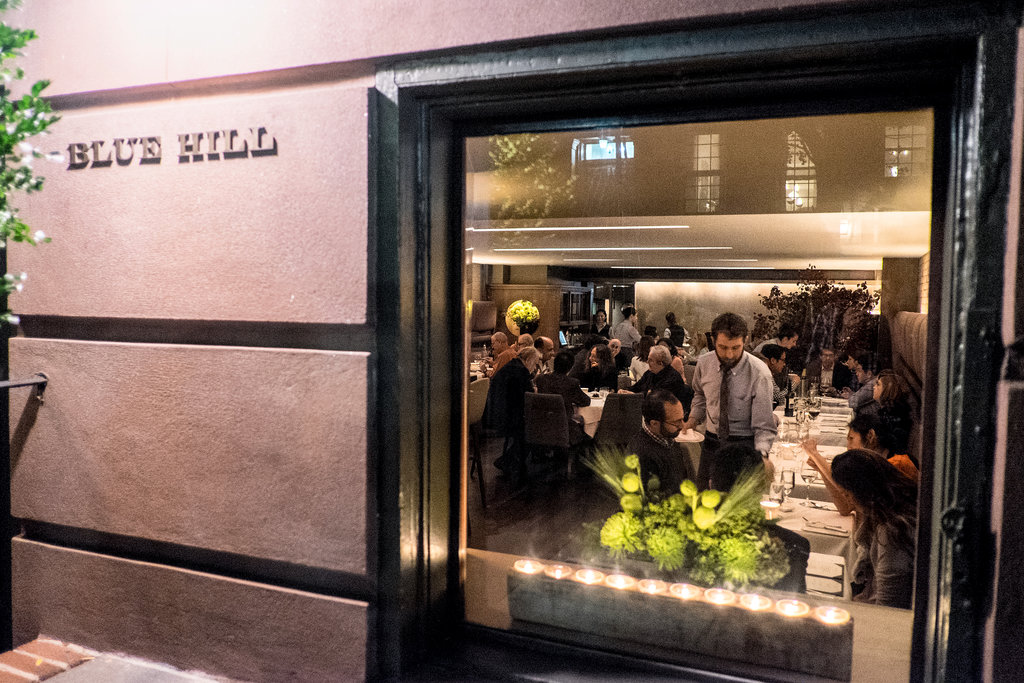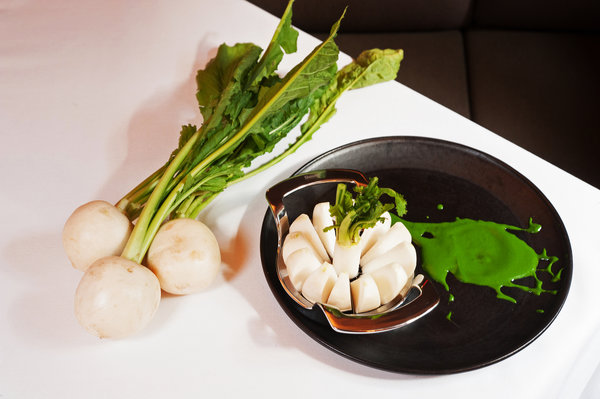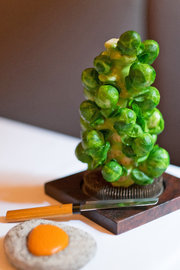
Blue Hill
CreditBen Russell for The New York Times
Halfway through dinner at Blue Hill, my server presented me with two squashes. One was the common football-size butternut that weighs down shopping bags at this time of year. The other had the same shape but was about as big as a sparrow. I held it in my palm. It felt good in there. Without thinking about what I was doing, I began petting it. The couple at the next table asked if they could see my tiny squash, and I let them stroke its smooth, cool skin. Before things got too weird, our server took my pet squash back to the kitchen.
When it came back, it had been roasted and cut in half. Specks of white pepper and strands of grated chestnut lay against its dark orange insides. It was sweeter than a normal butternut, but what I mostly noticed was that it tasted squashier, as if all the flavor had been compressed. Selective breeding was responsible, our server explained. Dan Barber, Blue Hill’s executive chef and a co-owner with his brother, David, had asked a Cornell agriculture professor to design a squash for him, making it as small and tasty as possible. The result is the 898 squash, served exclusively at Mr. Barber’s two restaurants, Blue Hill at Stone Barns in Pocantico Hills, N.Y., and this one, just off Washington Square Park.

Mr. Barber opened the one in Manhattan first, in 2000, with the idea of using local seasonal produce, including some from his family’s farm in the Berkshires. This put him in the company of, oh, several hundred other chefs. A few years later, though, he was chosen to lead an ambitious project at Stone Barns that combined a farm and a restaurant with research and education programs.
It turned out that he was born for the job. Patient, intense, curious, enthusiastic, articulate, Mr. Barber has become a dirt poet and kitchen philosopher whose time outside with the pigs and the beans has had a deep, lasting effect on the way he cooks. Today no other chef has the information he keeps in his head (how to make pure carbon out of a cow’s femur) or the vegetables he puts in his ovens (sparrow-size squash).

To get the Full Barber, you have to go to Stone Barns for a $198 menu-free, open-ended meal that may include, if you’re lucky, a tour of the manure shed where hot compost is put to work as cooking fuel. The original Blue Hill sits in the English basement of a townhouse in Greenwich Village, a historically tolerant neighborhood whose tolerance does not extend to manure sheds. The city doesn’t afford the time or space for the leisurely unfurling of Mr. Barber’s complete vision of how our appetites should fit into the land and the climate. The low-ceilinged space is too much like a saloon, the tables too close together, the restaurant’s many ardent admirers too accustomed to treating it as a place to catch up over an excellent weeknight dinner.
If Blue Hill had as many cooks and servers as its more favored sister upstate, they would probably iron out wrinkles like the long, stranded layovers between courses; the wineglasses that sat empty and were finally cleared with no offer of fresh ones; and the $23 glass of Rully poured ice-cold, so it was clenched and astringent. It also seems far out of character that this intensely local restaurant sells just two New York wines on its Francophilic (and not very value-minded) list, and that its only cider comes from California when there is a cider revival going on in Mr. Barber’s own, apple-rich state.

But while it may give you only a Half Barber, Blue Hill is still an exceptional restaurant. Mr. Barber’s long search for flavor out of town pays off downtown, where you find yourself thinking, again and again, that each new ingredient may well be the best example of its kind you’ve ever tasted. For this reason and others, Blue Hill is one of the few New York restaurants that seem to get better and more original as time goes by. This was true the last time it was reviewed in The New York Times, in 2006, when Frank Bruni brought it from two stars to three, and it is true now.
Dinner at Blue Hill can go in one of two directions: a four-course, $85 menu that you choose, or a longer, free-form “farmer’s feast” chosen by Mr. Barber or his chef de cuisine, Shingoon Hong, for $98 or $125, depending on how hungry the farmer is. Either way, the night will include a couple of surprise cameos by fruits and vegetables that drop in like the kooky neighbors in a sitcom.
A meal in September started with wispy young fennel stalks that had a clean and pure licorice sweetness and ended with firm, green-skinned, yellow-fleshed plums on ice. Both made me happy I had come to Blue Hill then, not a week sooner or later, which is the effect that certain fruits and vegetables can have when they’re picked at the right time. In a more recent meal, the kitchen sent out a raw hakurei turnip as big as an apple. In fact, it had been pushed through an apple slicer. I picked up a white wedge, swiped it through a pool of tarragon vinaigrette and braced for the harsh turnip aftertaste that never came. I won’t tell you that I ate the whole thing, or that it was as sweet and juicy as an apple, but it came much closer than I would have thought possible.
When it comes to actual cooking, Mr. Barber’s approach is to intensify ingredients that are pretty intense already. Looking at the saturated orange color of fat slabs of roasted carrot “cutlet,” I could tell it was going to taste richer and rounder than any carrot I had met before. The approach works on things that once had a pulse, too. Grass-fed, dry-aged veal, carved into a sampler of cuts, some fattier, some leaner, was ruddier and more bloody-tasting than most veal, but it still had a focused, refined taste that set it apart from beef. The caramelized outside edge of a slowly roasted neck from a Blue Hill Farm goat had a profoundly satisfying chew; the meat hiding under it was astoundingly tender and juicy. It had some of the primal pleasures of barbecue, and I wanted to tear into it with my hands.
In the early days of Blue Hill, I respected the cooking but didn’t want to wallow around in it the way I do now. The whole complicated web that Mr. Barber oversees has many purposes, spinning off in all directions, but if you just sit down to dinner, you can believe that the point of the entire operation is to provide you with one delicious taste after another. And maybe it is.